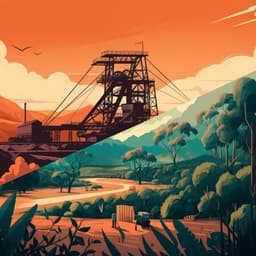
Environmental Studies and Forestry
Climate change has increased the odds of extreme regional forest fire years globally
J. T. Abatzoglou, C. A. Kolden, et al.
Global forests have faced devastating fire years; this study finds extreme regional fire years commonly coincide with 1-in-15-year fire weather indices and produce four- to five-fold increases in large fires and fire carbon emissions. Under a contemporary (2011–2040) climate such extreme FWI years are 88–152% more likely than in a quasi-preindustrial climate, especially in temperate and Amazonian forests. Research conducted by John T. Abatzoglou, Crystal A. Kolden, Alison C. Cullen, Mojtaba Sadegh, Emily L. Williams, Marco Turco, and Matthew W. Jones.
~3 min • Beginner • English
Introduction
The study investigates how antecedent and concurrent climate variability enables extreme regional fire years in global forests and quantifies the contribution of anthropogenic climate change to these extremes. Extreme fire years—characterized by widespread regional activity and exceptional burned area—have recently occurred in Australia (2019–2020), the western US (2020), and Canada (2023), producing substantial societal, environmental, and economic impacts. Although global burned area has declined due to land-use changes in savannas, both burned area and fire carbon emissions have risen in forest biomes, coincident with stronger and longer fire weather seasons and fuel-rich, flammability-limited landscapes. Human actions—including legacy fire suppression, agricultural land abandonment, deforestation, and contemporary suppression practices—have altered fuel loads, continuity, and sensitivity of fire to climate, particularly in tropical forests where agricultural drivers intensify fires during drought. Existing attribution studies often examine specific events or regions using varied methods, limiting cross-geographic comparison. This work adopts a consistent framework to identify extreme fire years as the maximum burned area year (2002–2023) per region and applies an attribution analysis to assess how climate change has altered the probability of climate-enabled extreme fire years across forested ecoregions globally.
Literature Review
Prior research documents declining global burned area driven by human land-use changes in savannas but rising burned area and fire emissions in forest biomes. Increases in fire activity are linked to more intense and prolonged fire weather and longer fire seasons, which synchronize fire danger and can overwhelm suppression capacity. Legacy fire suppression and land abandonment have increased fuel loads and continuity, predisposing regions to larger, more severe fires, while tropical deforestation for industrial agriculture provides economic and ignition drivers that amplify drought impacts. Attribution studies have generally found that anthropogenic climate change increases the likelihood and magnitude of fire-weather extremes and fire potential, though many analyses are geographically constrained and use diverse methods and indicators (burned area, event typologies, single events). Global-scale analyses have often focused on interannual climate-fire correlations or sub-seasonal extreme events rather than full-year extremes, motivating a unified global assessment of extreme fire years and their climate drivers.
Methodology
Extreme regional fire years were defined as the year with the greatest forested burned area during 2002–2023 for each analysis region (countries, multi-country regions, and ecoregions with ≥20% forest cover), using MODIS MCD64A1 burned area (500 m; March 2002–February 2024) and MODIS Vegetation Continuous Fields (MOD44B) to isolate forested burned area (pre-fire tree cover ≥20%). The fire year was set to March–February to better capture Southern Hemisphere seasonality. Fire carbon emissions were obtained from GFED4s (2002–2023), restricted to boreal and temperate forest fires and deforestation/degradation sources. Individual fire event attributes (number of fires and sizes) were taken from the Global Fire Atlas (March 2002–February 2024), defining very large fires as ≥100 km² in case-study regions and, for ecoregions, as the top 1% by size.
Meteorological data (ERA5, 0.25°, 1979–2024) were used to compute the Canadian Forest Fire Weather Index (FWI) using daily maximum temperature, minimum relative humidity, precipitation, and mean wind speed, with an overwintering procedure for initial conditions. Three annual FWI metrics were analyzed: days per year above the local 95th percentile (FWI95d), annual maximum FWI (FWImax), and maximum 90-day moving mean FWI (FWIs; also denoted FWI90). Antecedent moisture (annual evapotranspiration and precipitation) for the prior one and two years was examined. Climate metrics were ranked relative to the observational period (1979–2023), and return periods were estimated via a generalized extreme value (GEV) analysis over 1979–2023.
Attribution analysis quantified how anthropogenic climate change altered the likelihood of climate-enabled extreme fire years by assessing the probability of exceeding the 1-in-15-year threshold for FWI metrics. FWI output from nine CMIP6 models (historical 1851–2014; SSP2-4.5 2015–2040), each with ≥3 ensemble members and daily minimum RH to compute FWI, was used without bias correction to preserve the climate-change signal. For each model, ensemble years were pooled to estimate the 15-year return magnitude based on 1979–2023 and the exceedance probabilities for the quasi-preindustrial (1851–1900) and contemporary (2011–2040) periods. Risk ratios (RR) were calculated as the ratio of contemporary to quasi-preindustrial exceedance probabilities, with bootstrap resampling (n=1000) to assess 95% confidence intervals. Results are summarized using the 9-model median. The attribution estimates rely on early-industrial historical forcings rather than purely natural forcings.
Key Findings
• Extreme regional fire years typically coincided with statistically rare fire-weather conditions: across case studies and ecoregions, FWI metrics during the extreme year frequently exceeded 1-in-15-year thresholds (GEV over 1979–2023). Six of eight case-study regions had FWI metrics at or above the 1-in-15-year return period.
• Burned area and fire behavior during extreme years were markedly elevated: compared with non-extreme years, extreme years featured about a four-fold increase in the number of large fires and a five-fold increase in fire carbon emissions (case-study synthesis). At the ecoregion scale, medians showed a 73% increase in number of fires, a 321% increase in very large fires, and a 405% increase in carbon emissions.
• Antecedent moisture (precipitation and evapotranspiration) in the prior 1–2 years showed little systematic relationship with forested burned area, supporting the dominance of flammability-limited regimes where within-season fire weather is more influential.
• Climate attribution indicates a substantial increase in the likelihood of extreme fire-weather years under contemporary climate (2011–2040) compared to quasi-preindustrial (1851–1900). Multi-model median risk ratios for exceeding the 1-in-15-year FWI thresholds were 1.88–2.52 across metrics (FWIs and FWI95d largest; FWImax smaller).
• The odds of such FWI extremes have increased by 88–152% across forested ecoregions globally, with the largest increases in Amazonian ecoregions (over fourfold). Regions like the western US, Mediterranean, and Amazon showed strong agreement among models (RR ≥ 2), while boreal regions (northwestern Canada, Alaska, Siberia) exhibited more uncertainty and, in some models, decreased probabilities linked to increased summer precipitation.
• Globally, 46–65% of forested areas showed a doubling or more in the likelihood of 1-in-15-year FWI extremes (RR ≥ 2), while only 3–8% showed decreased likelihood (RR ≤ 1).
Discussion
The findings demonstrate that extreme regional fire years in global forests are largely enabled by rare, concurrent fire-weather conditions rather than by longer-term antecedent moisture anomalies, consistent with flammability-limited regimes. FWI extremes reflect the combined effects of prolonged warmth and aridity, persistent atmospheric blocking, and capstone weather events (e.g., dry frontal passages, downslope winds, and pyroCb activity). Temperate and boreal regions—especially in the latter part of the record—show strong alignment between extreme fire years and extreme FWI, with human-driven fuel accumulation and continuity (due to suppression, rural land abandonment, forestry practices, and non-native species) exacerbating fire growth under extreme weather.
In tropical regions affected by deforestation and agricultural burning, extreme fire years often occurred under moderate-to-severe drought with more complex human drivers; the temporal clustering of extremes earlier in the record may reflect declining deforestation rates, though recent events (e.g., 2024 in parts of the Amazon) underline ongoing vulnerability under record drought and chronic FWI. The weaker role of antecedent moisture suggests limited transferability of these results to fuel-limited non-forested landscapes (e.g., grasslands, shrublands), where prior-season productivity can be more important.
Attribution results provide robust evidence that anthropogenic climate change has substantially increased the odds of climate-enabled extreme fire years, with the largest changes in Amazonian and many temperate ecoregions. The smaller RR for FWImax likely reflects the influence of wind extremes, which are more uncertain under climate forcing, whereas temperature-driven fuel drying strongly amplifies chronic metrics like FWIs and FWI95d. These findings have immediate implications for fire management: traditional suppression-centric strategies are increasingly untenable during extreme regional fire years characterized by simultaneous large fires and resource shortages. Proactive adaptation—fuel reduction, ignition prevention, and resilience measures for communities and ecosystems—must complement climate mitigation to manage rising risks.
Conclusion
This study provides a global, cross-ecoregion assessment showing that extreme regional fire years in forests commonly co-occur with rare fire-weather extremes and that human-caused climate change has significantly increased the likelihood of such years. Using consistent observational and modeling frameworks, the work quantifies increased probabilities of exceeding 1-in-15-year FWI thresholds, with multi-model median risk ratios of 1.88–2.52 and the greatest increases in Amazonian and many temperate regions. Extreme years are marked by substantially elevated burned area, numbers of very large fires, and carbon emissions, underscoring their disproportionate impacts.
Future research should integrate finer-scale climate and land-surface processes (including downscaling and wind/instability extremes), non-stationary extreme value methods, and explicit representation of human drivers (deforestation dynamics, suppression, ignition sources). Expanded datasets distinguishing wildland fire from other biomass burning, and improved coupling of climate-fire-attribution frameworks with socioecological impacts, will enhance risk evaluation and management planning. Proactively shifting toward adaptation—fuel treatments, beneficial fire restoration, ignition prevention, and community resilience—alongside emissions mitigation is essential to address increasingly frequent extreme fire years.
Limitations
Key limitations include reliance on MODIS burned area, which does not distinguish wildland fires from agricultural and deforestation burning; focus on forested ecoregions (>20% forest cover), limiting transferability to non-forested regions; use of nine CMIP6 models constrained by availability of variables necessary to compute FWI and ≥3 ensemble members; absence of bias correction for model FWI to preserve climate signals but limiting direct comparison of absolute values; inability to resolve finer-scale processes and land-surface feedbacks due to non-downscaled model output; heterogeneous ecoregion spatial scales affecting signal-to-noise and comparability of risk ratios; use of stationary GEV over fixed periods rather than fully non-stationary extremes; attribution based on early-industrial historical forcings rather than purely natural forcings; and potential uncertainties in wind-related extremes affecting FWImax responses.
Related Publications
Explore these studies to deepen your understanding of the subject.







